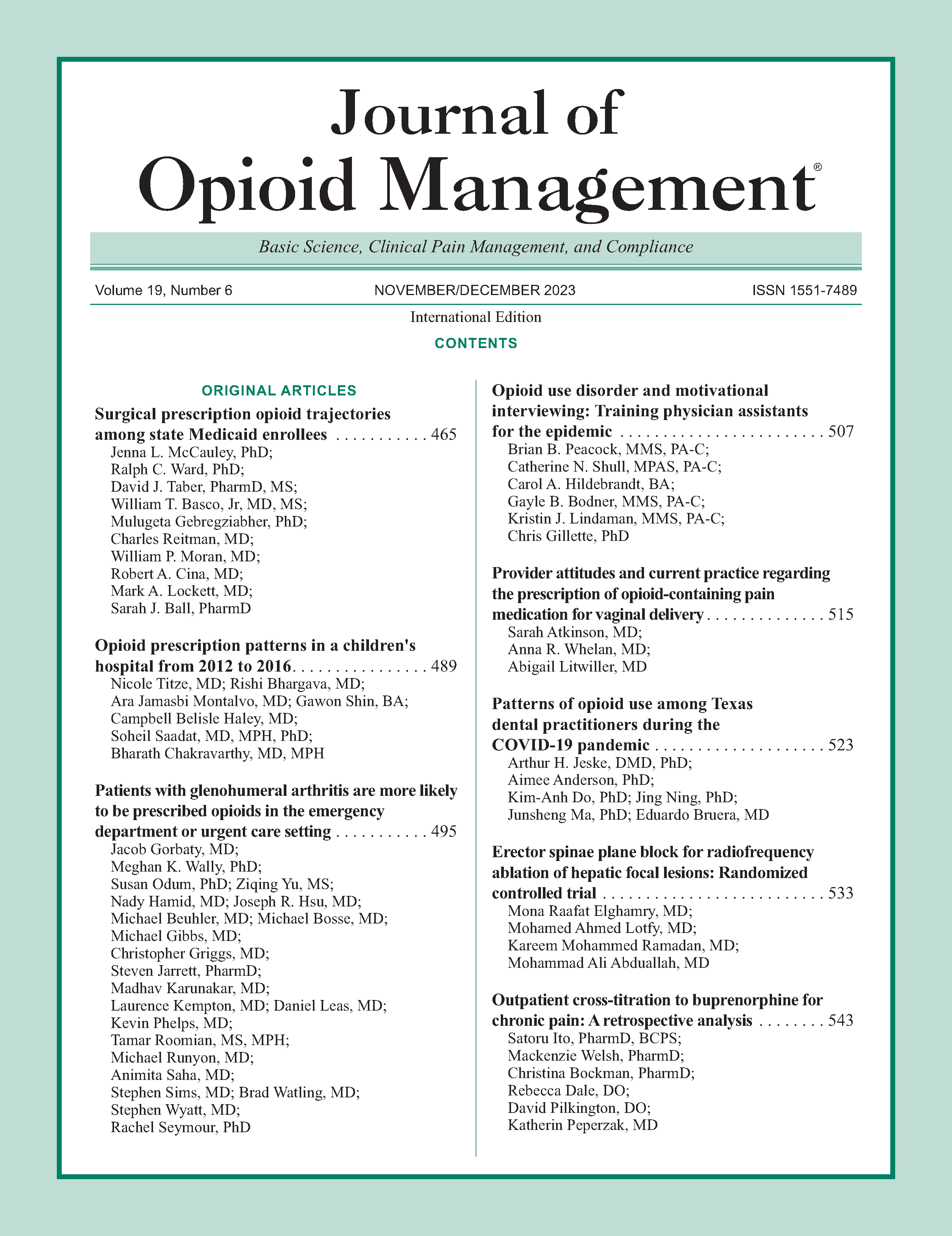Patterns of opioid use among Texas dental practitioners during the COVID-19 pandemic
DOI:
https://doi.org/10.5055/jom.0837Keywords:
opioids, dental, prescribing, surveyAbstract
Objective: The primary objective of this study is to assess factors that influence opioid prescribing by dentists and the role of these factors in the practice of dental pain control.
Design: A 25-question survey instrument was distributed to the study population for anonymous responses, covering dentist and practice demographics and opioid prescribing characteristics.
Setting: Private solo and group practice settings, including general practitioners and dental specialists.
Participants: Potential participants included all active members of a large state dental professional association.
Main outcome measures: They were practitioner and practice demographic traits, types of opioids prescribed, and statistical correlations. Outcome variables included practice type, practitioner gender, practice location, practice model, and years in practice. Categorical covariates were summarized statistically by frequencies and percentages, and continuous covariates were summarized by means, medians, ranges, and standard deviations.
Results: Strongest correlations with opioid prescribing included general practitioner (vs specialist) and male gender. The coronavirus disease 2019 pandemic was confirmed as having exerted a significant impact on opioid prescribing among the survey respondents.
Conclusions: Further research is warranted to assess post-pandemic opioid prescribing patterns, and additional educational strategies regarding limitations of opioid prescriptions should be applied to general, rather than specialty, dental practitioners.
References
Texas Administrative Code: Title 22, Examining Boards, Part 5, State Board of Dental Examiners, Chapter 111, Standards for Prescribing Controlled Substances and Dangerous Drugs, Rule 111.1, Additional Continuing Education Required.
Stoicea N, Costa A, Periel L, et al.: Current perspectives on the opioid crisis in the US healthcare system: A comprehensive literature review. Medicine. 2019; 98(20): e15425. DOI: https://doi.org/10.1097/MD.0000000000015425
Hetherington L, Johnston B, Kotronoulos G, et al.: COVID- 19 and hospital palliative care—A service evaluation exploring the symptoms and outcomes of 186 patients and the impact of the pandemic on specialist hospital palliative care. Palliat Med. 2020; 34(9): 1256-1262. DOI: https://doi.org/10.1177/0269216320949786
Martinho FC, Griffin IL: A cross-sectional survey on the impact of coronavirus disease 2019 on the clinical practice of endodontists across the United States. J Endod. 2021; 47(1): 28-38. DOI: https://doi.org/10.1016/j.joen.2020.10.002
Heron MJ, NWokonie NA, O'Connor B, et al.: Survey of opioid prescribing among dentists indicates need for more effective education regarding management. J Am Dent Assoc. 2021; 153(2): 110-119. DOI: https://doi.org/10.1016/j.adaj.2021.07.018
Richard P, Bauer MR, Moresco N, et al.: Opioid prescribing for surgical procedures in dental clinics of military treatment facilities. J Am Dent Assoc. 2021; 152(2): 94-104.e18. DOI: https://doi.org/10.1016/j.adaj.2020.09.020
Bsoul BA, Challa SN, Loomer PM, et al.: Multifaceted impact of COVID-19 on dental practice. J Am Dent Assoc. 2022; 153(2): 132-143. DOI: https://doi.org/10.1016/j.adaj.2021.07.023
Chua K, Hu H, Waljee J, et al.: Opioid prescribing patterns by dental procedure among US publicly and privately insured patients, 2013 through 2018. J Am Dent Assoc. 2021; 152(4): 309-317. DOI: https://doi.org/10.1016/j.adaj.2021.01.001
Moore PA, Ziegler KM, Lipman RD, et al.: Benefits and harms associated with analgesic medications used in the management of acute dental pain: An overview of systematic reviews. J Am Dent Assoc. 2018; 149(4): 256-265. DOI: https://doi.org/10.1016/j.adaj.2018.02.012
Moore RA, Derry S, Aldington D, et al.: Single-dose oral analgesics for acute postoperative pain—An overview of Cochrane reviews. Cochrane Database Syst Rev. 2015: CD008659. DOI: https://doi.org/10.1002/14651858.CD008659.pub3
Moore PA, Dionne RA, Cooper SA, et al.: Why do we prescribe Vicodin? J Am Dent Assoc. 2016; 147(7): 530-533. DOI: https://doi.org/10.1016/j.adaj.2016.05.005
Campitelli MA, Bronskill SE, Mclagan LC, et al.: Comparison of medication prescribing before and after the COVID-19 pandemic among nursing home resident in Ontario, Canada. JAMA Netw Open. 2021; 4(8): e2118441. DOI: https://doi.org/10.1001/jamanetworkopen.2021.18441
Published
How to Cite
Issue
Section
License
Copyright 2005-2025, Weston Medical Publishing, LLC and Journal of Opioid Management. All Rights Reserved.











